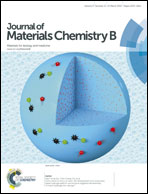From macro to micro to nano: the development of a novel lysine based hydrogel platform and enzyme triggered self-assembly of macro hydrogel into nanogel
Abstract
A novel L-lysine based multifunctional crosslinker family was developed and utilized to fabricate a 100% pure poly(ester amide) (PEA) hydrogel with unique structure via a novel gelation strategy in a single and rapid step. Enzyme triggered biodegradation was utilized to turn the resultant macro hydrogel into abundant microgels with a 3 micron size in the early stage. Nanogels of 50 nm in diameter were then formed after 8 days of biodegradation in the enzyme solution. The enzyme degradation of doxorubicin (DOX) loaded macro-gel indicated that the micro and nano gels containing DOX could be obtained using the same strategy while retaining their sustained drug release performance. This study reports a new biocompatible and biodegradable crosslinker and hydrogel system, and illustrates a new nanotechnology capable of controllably producing nanogels using the enzymatic degradation of macro hydrogels.


 Please wait while we load your content...
Please wait while we load your content...